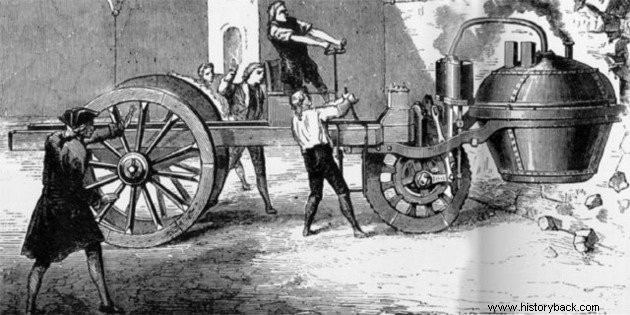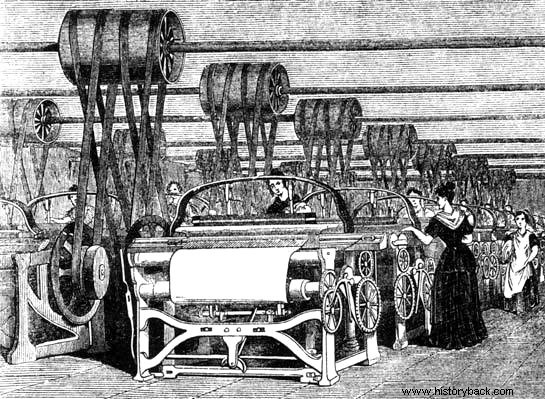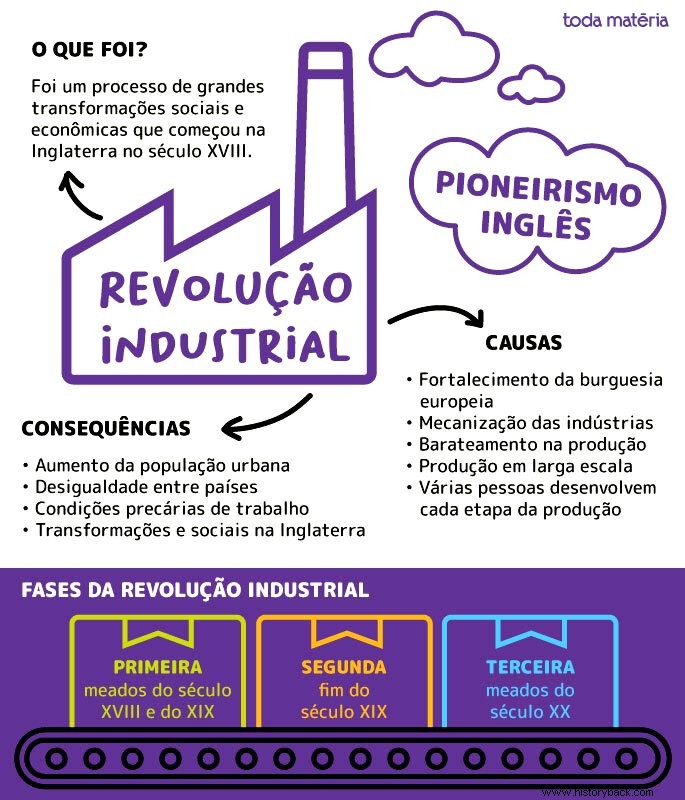The Industrial Revolution was a process of great social and economic transformations that began in England in the 18th century.
The industrial mode of production spread across much of the Northern Hemisphere throughout the 19th and early 20th centuries. Producing goods became cheaper and more accessible, but it brought the disorganization of rural life and damage to the environment.
The advent of large-scale mechanized production started the transformations of European and North American countries. These nations became predominantly industrial and their populations were increasingly concentrated in cities.
Therefore, the industrial revolution is characterized as the process that led to the replacement of tools by machines, human energy by motive energy and the domestic (or artisanal) production mode by the factory system.

Causes of the Industrial Revolution
The expansion of international trade in the 16th and 17th centuries brought an extraordinary increase in wealth to the bourgeoisie. This allowed the accumulation of capital capable of financing technical progress and the high cost of installation in industries.
The European bourgeoisie, strengthened and enriched, began to invest in the development of projects to improve production techniques and in the creation of machines for industry.
It was soon found that greater productivity and increased profits were achieved when machines were used on a large scale.
See also:Causes of the Industrial RevolutionConsequences of the Industrial Revolution
The long path of discoveries and inventions was a way of distancing countries from each other in terms of economic and political power.
After all, not all of them industrialized at the same time, remaining in the condition of suppliers of raw materials and agricultural products to industrialized countries.
These differences still mark the nations of the world that are divided between developed and developing countries . One of the ways to measure if a country is advanced is to assess how much it is industrialized.
See also:Consequences of the Industrial RevolutionStages of the Industrial Revolution
It was in England that the phenomenon of industrialization began and that is why the English Industrial Revolution was a pioneer. Several factors explain the reasons for this primacy.
England had the capital, political stability and necessary equipment to take the lead in the advance of Industry.
Since the end of the Middle Ages, a significant part of the population moved to cities due to enclosures (enclousers ) from Camp. Without land, peasants ended up entering the factories that emerged.
It also had colonies in Africa and Asia that guaranteed the supply of raw materials with cheap labor.
First Industrial Revolution
The First Industrial Revolution took place in mid 18th and 19th century . Its main feature was the emergence of mechanization that brought about significant transformations in almost all sectors of human life.
In the socioeconomic structure, there was a definitive separation between capital, represented by the owners of the means of production, and work, represented by wage earners. This eliminated the old organization of guilds or guilds that was the mode of production used by artisans.
In this way, the first factories were created that house many workers in the same space. Each one must operate a specific machine to perform its task.

Due to low pay, subhuman working and living conditions, workers organize themselves. In this way, they joined together in labor organizations and unions to demand better shorter working hours and higher wages.
Mechanization has extended from the textile sector to metallurgy, transport, agriculture, livestock and all other sectors of the economy, including the cultural sector.
The Industrial Revolution established the ultimate bourgeois supremacy in the economic order. At the same time, it accelerated the rural exodus, urban growth and the formation of the working class. It was the beginning of a new era, where politics, ideology and culture gravitated towards two poles:the industrial and financial bourgeoisie and the proletariat.
Factories employed large numbers of workers. All these innovations influenced the acceleration of contact between cultures and the very reorganization of space and capitalism.
In this phase, the State started to participate more and more in the economy, regulating economic crises and the market and creating an infrastructure in sectors that required many investments.
Second Industrial Revolution
From theend of the 19th century , capitalism became less and less competitive and more monopolistic. Only a few companies or countries dominated production and trade. It was the phase of financial or monopoly capitalism , a hallmark of the Second Industrial Revolution.
At this time, the German Empire emerged as the great industrial power. With an abundance of iron ore and a military culture, the Germans, led by Prussia, carry out political and economic reforms that will unify the country and endow it with a powerful industry.
Since then, the bases of technological and scientific progress have been established, aiming at innovation and constant improvement of products and techniques, to improve industrial performance.
Third Industrial Revolution
The culmination of industrial development, in terms of technology, began in mid-twentieth century , around 1950, with the development of electronics. This allowed the development of information technology and the automation of industries .
In this way, industries were dispensing with human labor and increasingly depended on machines to manufacture their products. The worker intervened as a supervisor or in just a few stages of production.
This phase of new discoveries characterized the Third Industrial Revolution or information and technological revolution.
See also:Phases of the Industrial RevolutionSummary on the Industrial Revolution

Industrial Revolution in Brazil
While in England, in the 18th century, the Industrial Revolution took place, Brazil, still a Portuguese colony, was far from the industrialization process.
After independence, there were only isolated initiatives to install industries in Brazil. At the beginning of the 20th century, textile factories, mainly, appeared in São Paulo and Rio de Janeiro.
Industrialization in Brazil, however,only truly began in 1930 , one hundred years after the English Industrial Revolution.
During the government of Getúlio Vargas, the centralization of power in the Estado Novo created conditions for the work of economic coordination and planning to begin. Vargas placed emphasis on import substitution industrialization.
The Second World War (1939-1945) brought a slowdown to industrialization in Brazil, as it interrupted imports of machinery and equipment.
Even so, Brazil, through agreements with the United States, managed to found the Companhia Siderúrgica Nacional (1941) and Usiminas (1942).
After the conflict, the State would return to its investor activities and promote the creation of industries such as Petrobras (1953).
Also read about:
- French Revolution
Test your knowledge with Industrial Revolution Questions and First Industrial Revolution Questions.
Bibliographic References
Bahamonde, Miguel &Villares, Ramón - The contemporary world, acronyms XIX and XX. 2008. Ed. Taurus:Madrid.
Schlutz, Helga - Economic history of Europe, 1500-1800. Craftsmen, merchants and bankers. 2001. Siglo XXI Publishers:Madrid.
